
There are some burning questions I’m sure we all have about psychics, the psychic service industry, and spiritual beliefs as a whole. So, given the lack of similar content elsewhere on the internet, we thought we’d do some digging on the very best psychic, mediumship, and tarot statistics for 2021.
The facts and stats in this article should give you a clearer view of where things stand in the world of fortune-telling, mediumship, and psychic services in general. Enjoy!
Spiritual Beliefs
First, we’ll start things off by looking into the statistics behind spiritual beliefs around the world.
People love the enlightenment and guidance that a psychic, medium, or fortune-teller can bring them. In this section, we thought it would be fun to look at general attitudes around psychics, psychic beliefs, and how certain nations believe in spiritual teachings more than others.
How Many People Consult a Psychic? And Who Are They?
Based on a study from YouGov, around 1 in 5 (22%) of Americans say they have consulted a fortune-teller, medium, or psychic at some point in their life.
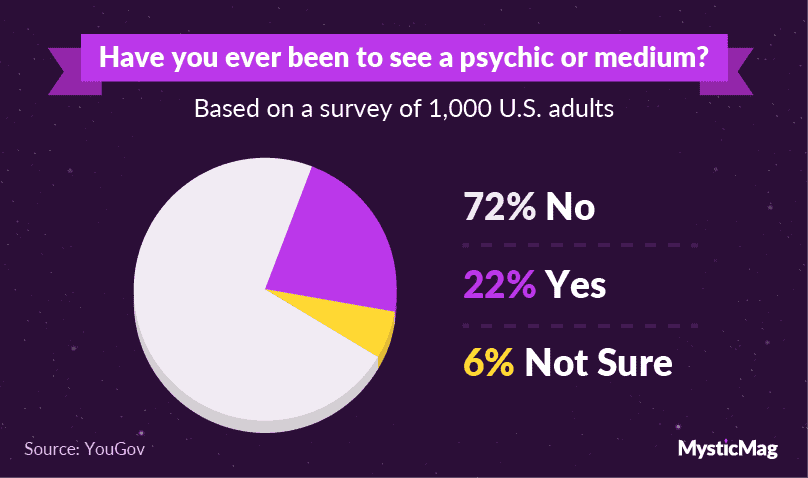
Amongst those respondents who are more spiritually attuned, women are more likely to have seen a psychic or medium than men.
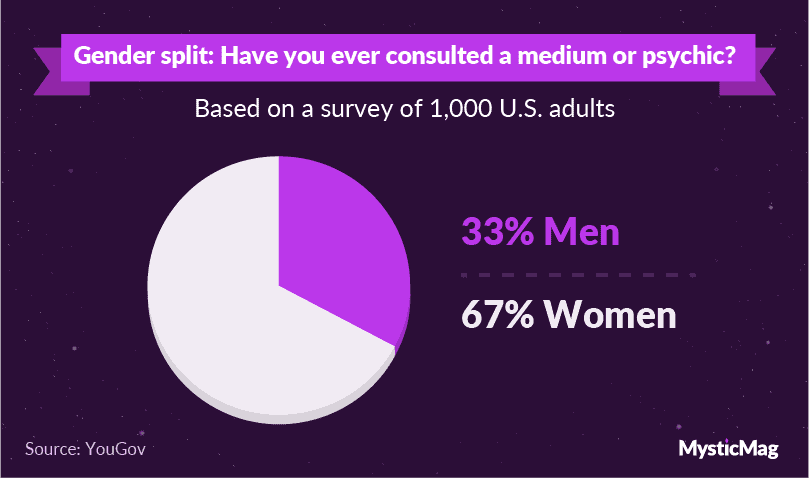
In fact, this is a common theme that returns throughout these statistics. Women are more likely to engage in psychic activities than men, which perhaps points towards greater openness and acceptance of spiritual beliefs.
Female psychics, too, are more likely to see another psychic than their male counterparts. Among psychics and tarot readers, 67% of surveyed women said they’d been consulted by another psychic. Just 13% of male psychics/tarot readers said the same. That’s quite far below the national average in the U.S.
It’s worth mentioning that the average age of men and women who go to see psychics is different, too. The average male who consults a psychic is aged 27-54, while females offer a broader range of psychic seekers, at 21-60 years old on average.
It’s important to note that these averages are steadily coming down, which suggests younger people are now finding their spiritual side earlier in life.
Another YouGov study, which took place in France in 2018, shows the percentage of French men and women who say they have consulted a psychic in their lifetime.
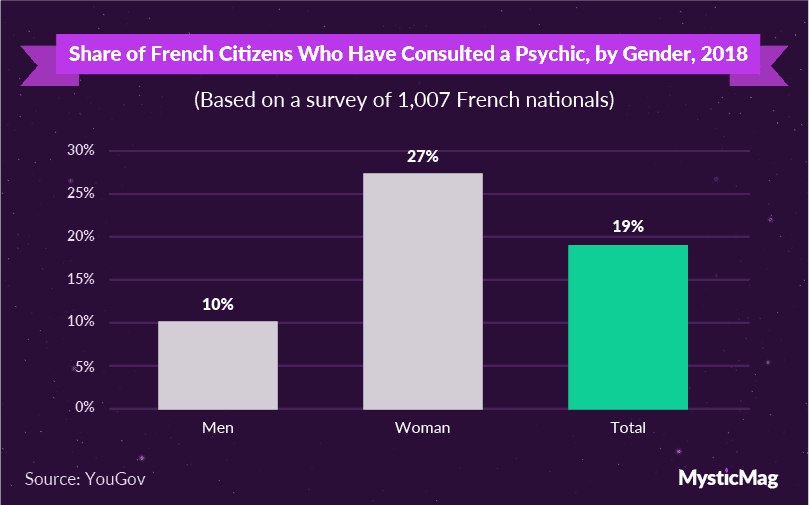
Of course, different nations can have vastly different spiritual beliefs. In the absence of a concrete global study, we must make do with studies done in numerous different locations.
The French study shows some consistency with the results from YouGov’s American survey: around 1 in 5 people say they have visited a psychic, and this number is greater amongst women.
However, in other countries, you can expect an alternative result. In Poland, for example, there is a strong spiritual community. This is because Poland has a strongly religious Catholic presence, not to mention a storied history of travelers, who are famous exponents of psychic practices.
In Poland, seeing a psychic, medium, or fortune-teller is extremely common. According to the Polish Ministry of Education and Science, around 50% of the nation’s population have seen a fortune-teller at some stage in their life.
How Often Do You Use Psychic Services?
Just how often do those within the spiritual community seek the guidance of a psychic service?
A Mobilesquared study in the UK looked at the use of tarot and astrology services. Specifically, the survey analyzed how often users of psychic services sought guidance.
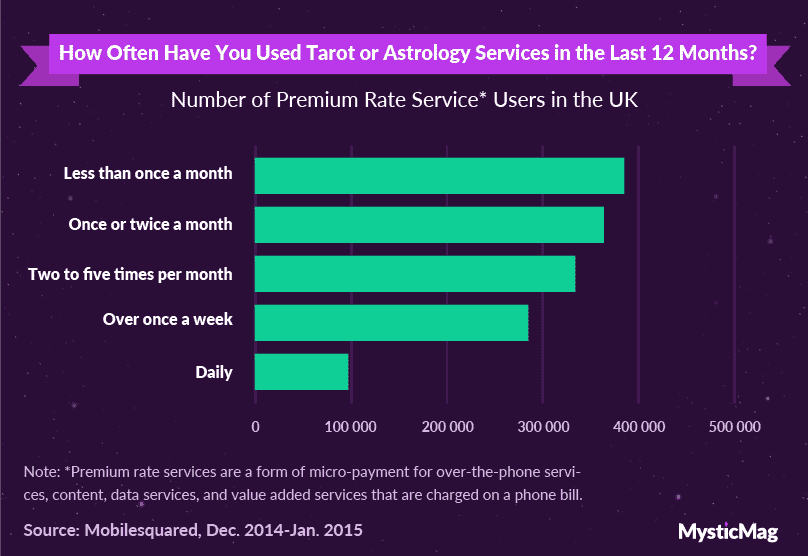
The study was conducted on users of tarot or astrology services. The data shows that a vast proportion of users check in for spiritual support less than once a month. The majority of people access psychic services 1 to 5 times every month, while nearly 400,000 respondents use psychic services several times every week.
Many people will get what they need from psychic services, even if it’s an occasional check-in. For nearly 100,000 people, a daily check-in is vital. These people are likely to place a lot of emphasis on spiritual teachings to guide them through life.
Belief in Psychics
While around 1 in 5 Americans have been to visit a psychic, overall belief in the psychic arts is much higher.
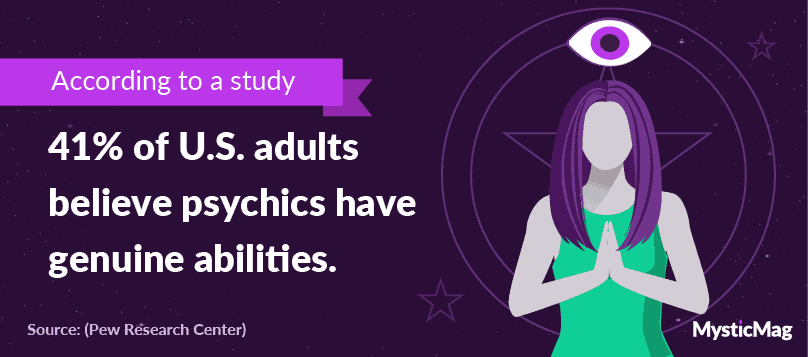
Psychics are defined as those people who are gifted with psychic abilities, specifically one or more of the 7 psychic abilities:
- Clairvoyance – the ability to see things clearly in the mind’s eye or the third eye, to have visions
- Clairaudience – the gift of clear hearing, with the ability to “hear” voices from the spirit realm
- Clairempathy – the ability to sense and feel emotion clearly, not just from individuals, but from spirits as well
- Clairsentience – a “gut feeling” or deeply connected sense of intuition. Clairsentient psychics can receive warnings before others
- Clairalience – an ability to smell what is being transmitted from the spirit realm, commonly a fragrance or odor
- Clairgustance – similar to clairalience, clairgustance is the ability to “taste” essences and flavors that are being transmitted from spirits, normally as a form of character or behavior that the spirit loves
- Clairtangency – known also as psychometry, is the ability to receive spiritual messages by touching or holding an object. The object is personal to the spirit and is full of its energy, personality, and history.
In the same study in which they tested American belief in psychics, the Pew Research Center conducted research on U.S. acceptance of several other “new age beliefs.”
New Age Beliefs
In this study, respondents across a wide range of demographics were tested based on their agreement to 4 new age beliefs.
Included within these beliefs are “psychics,” which we’ve already shown, as well as other popular spiritual/psychic ideologies such as reincarnation, astrology, and the belief that physical objects can be endowed with spiritual energy (essentially a belief in clairtangency).
First of all, Pew Research analyzed religious responses to these criteria.
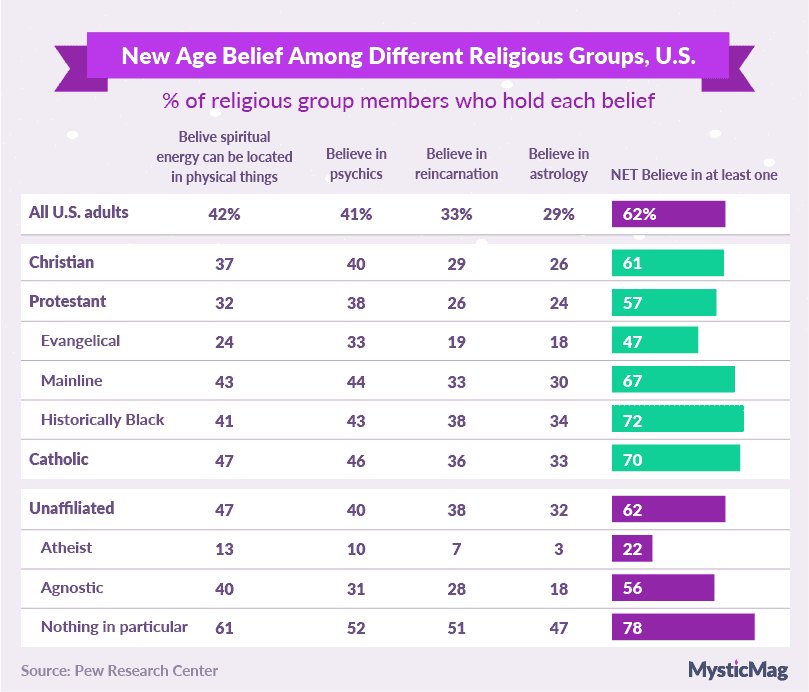
As you can see, around 6 out of 10 U.S. adults believe in at least one of these new age beliefs.
Christians are a deeply spiritual religious group, with some sects of the Christian religion achieving a high level of adherence to spiritual beliefs.
Catholics and members of the Historically Black church were the two most spiritual sects of Christianity, with 70% and 72% of member respondents holding at least one spiritual belief. Catholics also had the highest percentage of people who believe specifically in psychics.
Among all respondents, those who identify themselves as atheists had the lowest adherence to new age beliefs.
The Pew Research Center also broke the data down further in terms of gender, age, level of education, race, and political leaning.
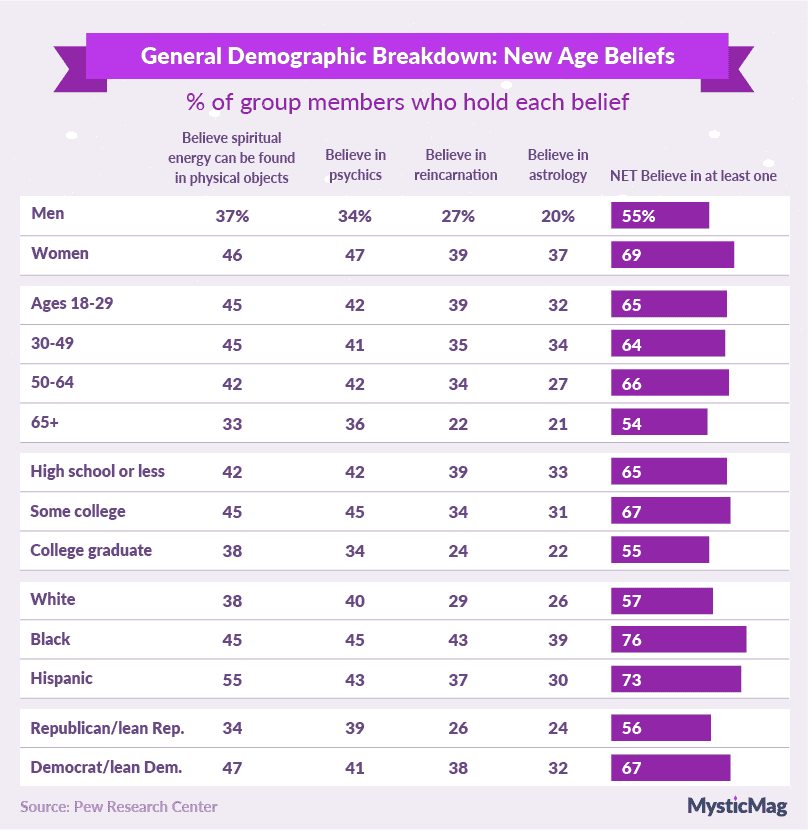
Women are more likely to have ‘new age” beliefs than men, which is consistent with our findings on male/female psychic participation.
Meanwhile, 50-64 is the average age of people who have these beliefs. Again, this is consistent with our participation data and shows that many people find their spiritual calling later in life.
Out of the 3 racial demographics analyzed in the study, African Americans were most likely to hold “new age” beliefs, while Democrats are far more spiritual than Republicans.
Spiritual People Have New Age Beliefs
Pew Research’s study eventually asked respondents about their spiritual identification, i.e. how spiritual they were, whether or not they were religious, and what a combination of these factors would mean for their adherence to “new age beliefs.”
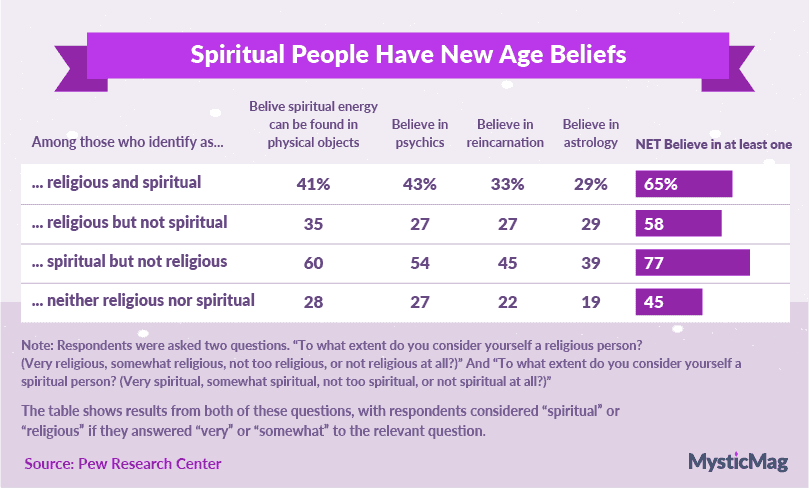
Those who identify as neither religious nor spiritual were most likely to reject new age beliefs altogether. Those people who have spiritual beliefs, but do not identify as religious, were most likely to agree with one of the 4 concepts posed to them in the question.
Belief in Mediums
So too are mediums a type of psychic. Specifically, mediums are those psychics who specialize in receiving messages from the spiritual realm, often from loved ones and lost relatives of those who are using a medium’s services.
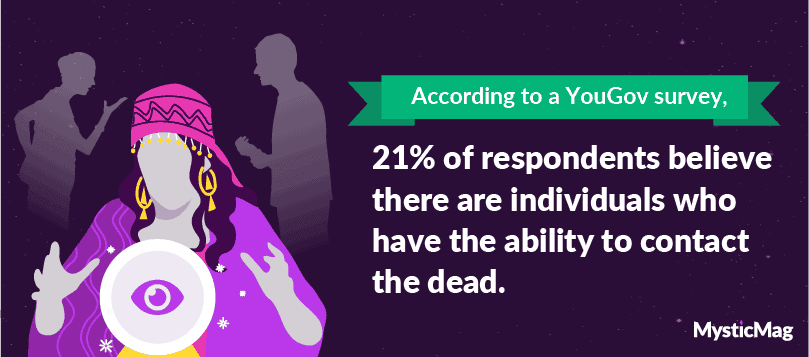
That works out to around 1 in 5 people, which is again concurrent with statistics on how many people generally believe in psychics.
People generally visit mediums for help in a variety of different ways. More often than not, people want to connect with a passed loved one because they are experiencing grief, a sense of loss, and/or they miss the loved one in question.
Mediums give us a chance to work through these feelings of grief by once again coming closer to those who have moved on. This can bring guidance, confidence, purpose, and emotional balance to your life. In the opinion of many, seeing a medium or psychic is a type of emotional counseling that can be hugely beneficial.
Belief in Fortune-tellers
Fortune-tellers are a specialized type of psychic, similar to mediums. They have expertise in predicting the future using various means such as visions, psychic abilities, tarot cards, palm readings, astrology, and other fortune-telling practices.
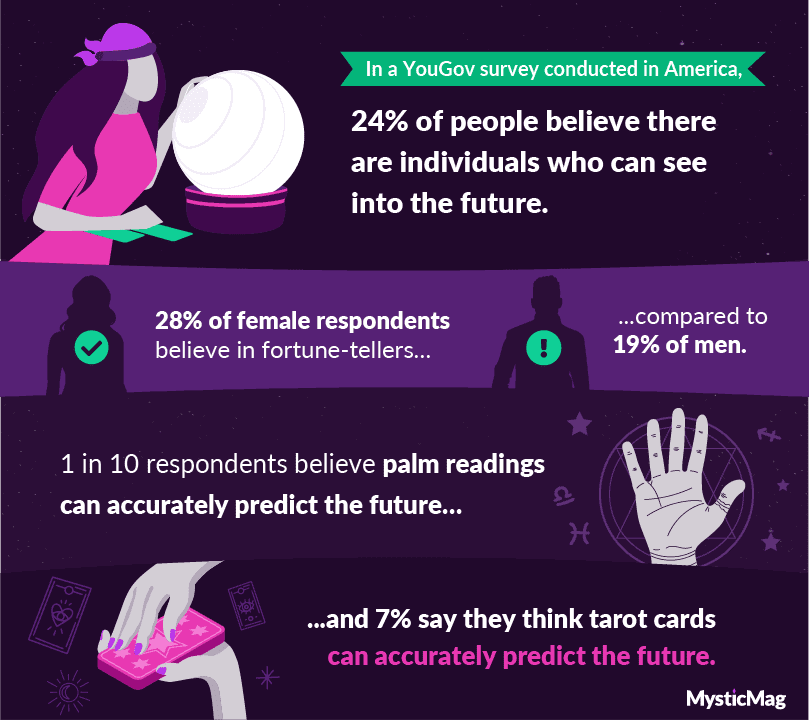
While the number of respondents who believe in palm readings and tarot cards was lower than expected, overall, around a quarter of respondents believe some people can see into the future.
Just north of the border, however, an Angus Reid Institute survey demonstrates that views can change drastically from nation to nation.
Canadians were asked the same question; “Do you believe there are psychics who can see into the future?”
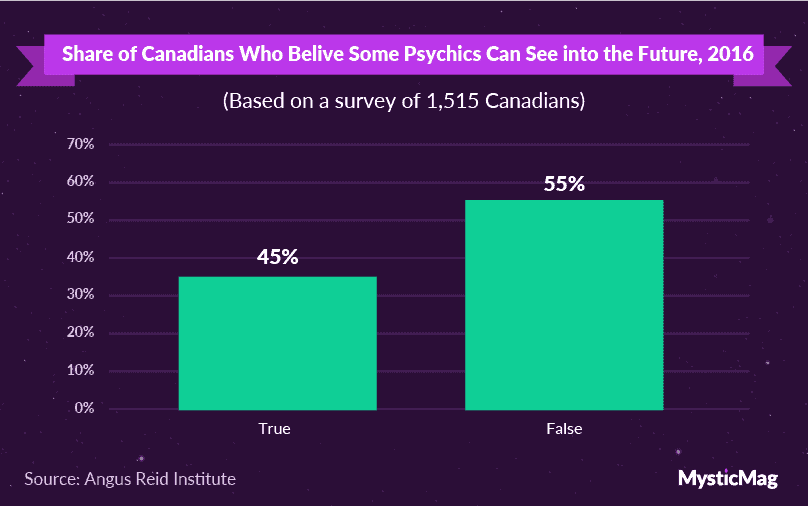
45% of respondents think that there are people who can see into the future. While a quarter of American respondents is already a significant proportion of people, the result from Canada just goes to show that fortune-tellers play an important role in many of our lives.
For those who use fortune-tellers regularly, this practice can bring you reassurance in the effect of your decisions; it can enhance your intuition, give you purpose, open your eyes to alternative propositions, and, importantly, provide you with clarity as you continue on your journey.
How Many People Have Had a Psychic Episode?
A psychic episode or occurrence is loosely defined as an encounter with the other side, i.e. the spiritual and psychic realm. This could be in the form of experiencing a spirit, spiritual energy, reading someone’s mind and emotions, or being on the end of a miraculous turn of fate, or premonition about the future.
So, how many people believe they have had contact with the spiritual and psychic realm themselves?
A YouGov survey set out to find exactly that information. Their survey asked respondents if they had experienced either a “psychic moment” (i.e. a premonition) or whether they had ever felt the presence of a being from the spiritual realm.
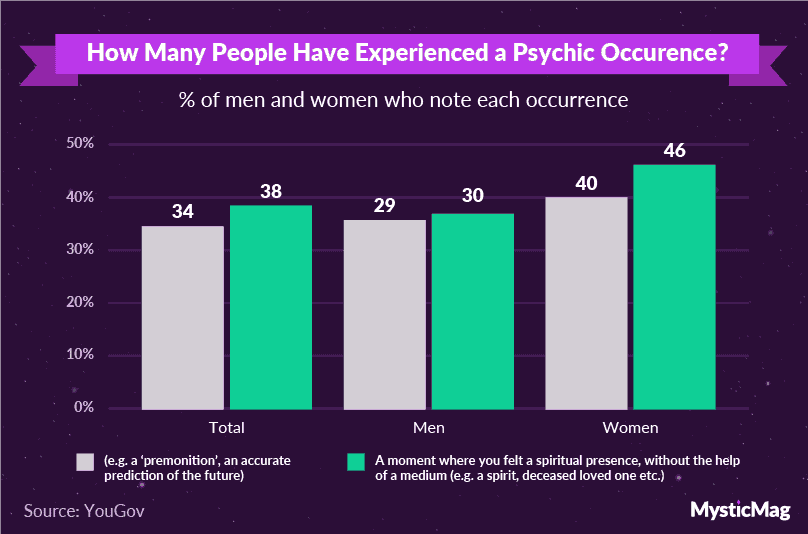
Overall, the survey found that more than a third of people believe they have had a psychic moment at some stage in their life. These experiences are more common among women than men; 40% of female respondents say they have experienced a psychic moment, as opposed to 29% of male respondents.
Experiences of spirits were slightly more common among both groups. 38% believe they have experienced the energy of a spirit, and this balance again swings in favor of women. 30% of men report meeting spirits, along with nearly half of all female respondents (46%).
Interestingly, the statistics show that many people are quick to identify their own experiences as “psychic.”
Belief in Spiritual or Supernatural Events
Spiritual events, “myths”, or “theories” (whatever you want to call them) are events/phenomena exclusive to spiritual (and some wider religious) trains of thought.
Granted, not all supernatural events are accepted by spiritual and psychic believers, but tracking the popularity of these ideas helps us to identify those spiritual stories that are most important.
In the US and Denmark, research has been conducted to find out which spiritual events are most important to people.
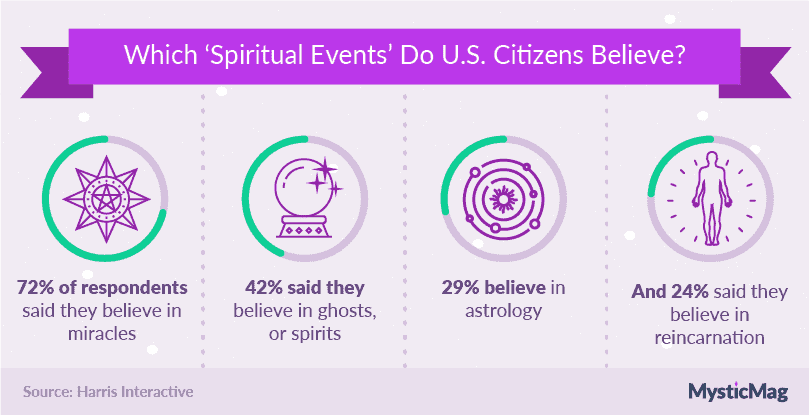
The results show that whilst many people claim to not believe in psychics, mediums, and elements of spiritual thought, in reality, many people believe in at least one element of spiritual practice.
In Denmark, a similar survey took place. Here, Aarhus Universitet asked respondents which spiritual and supernatural phenomena they believe in.
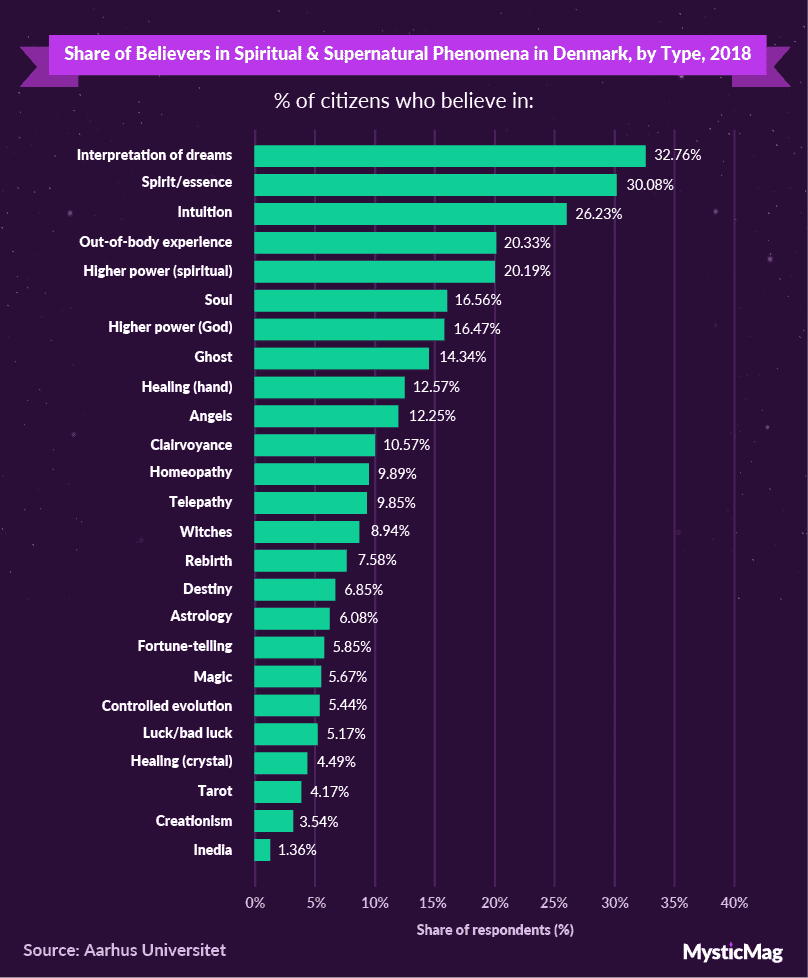
Indeed, some of the options included in the survey do not have a lot to do with spiritual practice and popular trains of thought. However, what’s interesting here is the widespread public belief in spirits and psychic callings, such as intuition.
Popularity of Divination
The divinatory arts (i.e. practices that foretell future events), like many other psychic and spiritual practices, provide some fantastic benefits to those who choose to use them.
Tarot cards and other divinatory experiences have helped many people get through dark times in their life. They can bring you joy, help you grow stronger, bring positive intentions, and invite reflection, awareness, hope, and forgiveness upon oneself.
Despite suggestions that divinatory arts are not largely accepted in some nations, these practices are a mainstream and popular pastime in many countries across the world.
In France, “French Tarot” is one of the most popular card games in the country. In a BVA survey, 43% of French citizens rated “French Tarot” as one of their favorite card games.
In this case, Tarot cards are not strictly being used for psychic readings, but the statistic still owes to their continued mainstream use and popularity. Tarot cards were invented in Italy in the mid-fifteenth century, and have been used throughout central Europe for hundreds of years since.
The Japanese, meanwhile, are avid believers in divination. The divinatory arts have been a part of Japanese culture for thousands of years, with its existence a major element of native Japanese magic.
Tarot cards, palm readings, and other forms of fortune-telling are therefore extremely popular in Japan. In the NRC survey results below, Japanese respondents were asked to pick their favorite form of divination.
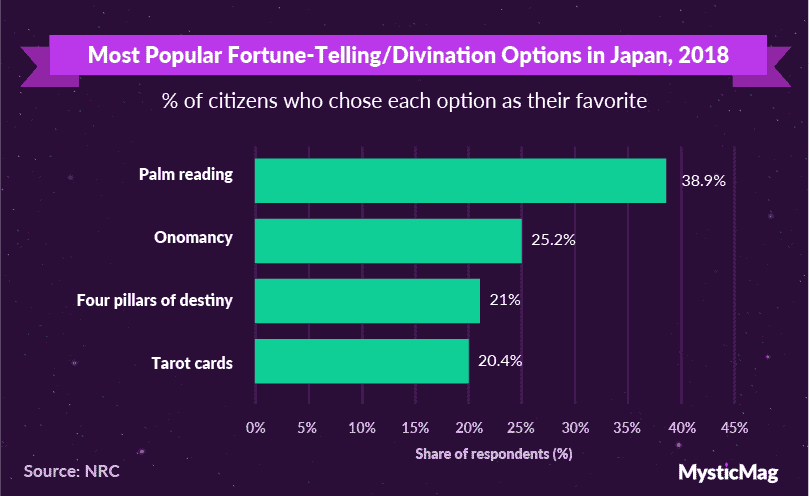
The results are relatively equal among all 4 types of fortune-telling, with palm reading the most widely accepted form of divination in Japan.
Where Else is Tarot Popular?
Of course, we’ve already established that Tarot is popular in Japan and France, but where else are tarot cards, and tarot readings, a common product/service?
A look at data tells us where the term is searched around the globe.
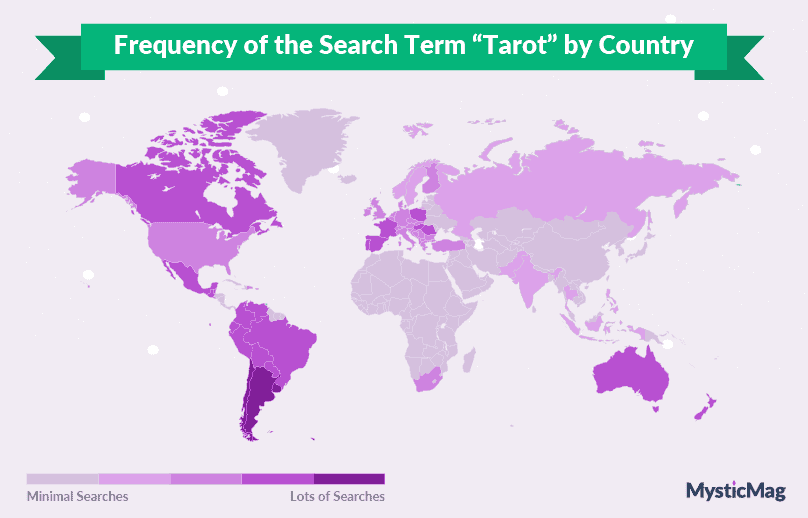
As we thought, central and southern Europe is one of the most popular regions for tarot card use. In particular, the term is searched a lot in France and Spain.
It seems the Argentines and Chilians have a taste for tarot card reading, too. These are the two most popular destinations for tarot searches in the Western Hemisphere.
Australia and the USA also have a relatively high frequency of “tarot” searches, while the activity is popular in parts of eastern Europe and the Middle East, too.
Patterns in Horoscope Use
A look at the “who” and “how” of horoscope use across France and Sweden can tell us a lot about astrology in general.
An IFOP study looked at the demographics of horoscope users in France, measuring how often each of these subgroups reads their daily horoscope.
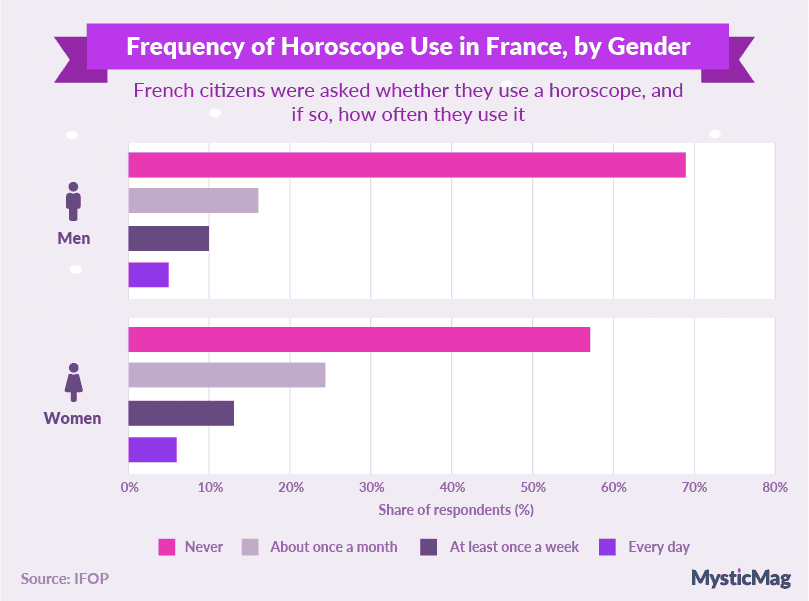
The IFOP’s gender data shows that men are less likely to use a horoscope than women, which again is concurrent with almost every aspect of spiritual practice.
Women who use a horoscope also revisit their horoscope more often than male counterparts, with some 19% of female respondents accessing materials once a month or more, compared to 15% of men.
While women are more likely to use a horoscope, they also place a greater emphasis on its guidance. Let’s take a look at what the age-aggregated data suggests.
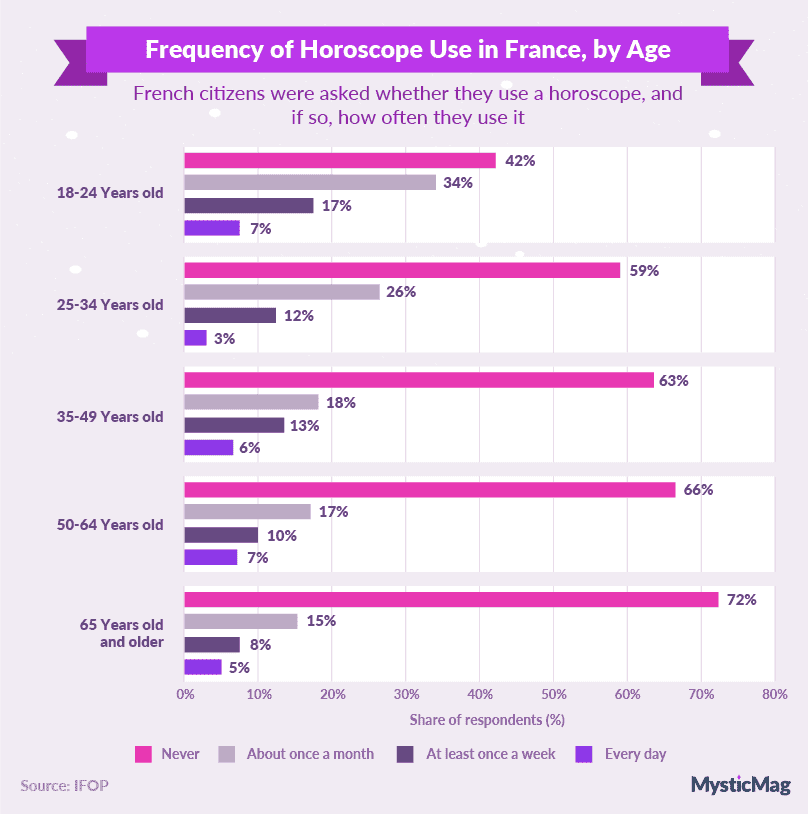
Other surveys we’ve looked at so far have shown that psychic beliefs are generally more common in older people. Interestingly, IFOP’s results show that young people are more likely to use an astrological horoscope chart.
18-24 year olds are the number one demographic based on age, and this group will use their horoscope more often than others.
The graphs show that the vast majority of people do not need to see the predictions in their horoscope every day, which is contrary to popular belief. Research from YouGov on Swedish horoscope users goes in-depth on the regularity with which people check their horoscope.
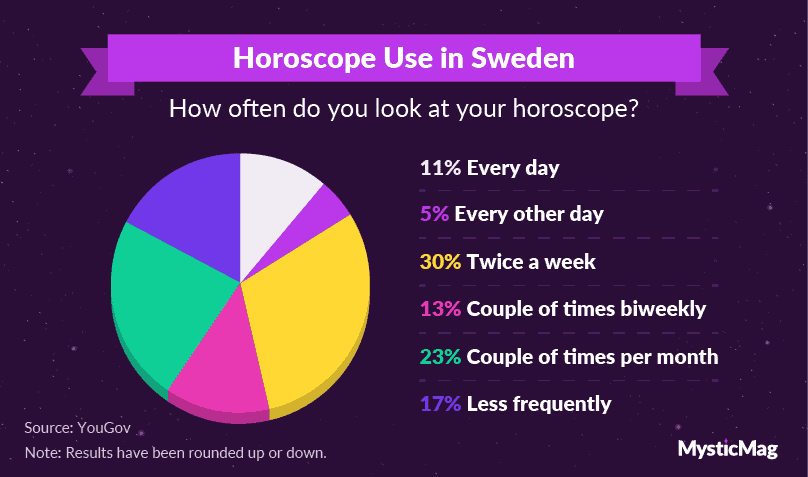
Similar patterns can be seen in YouGov’s data. Instead of daily doses, the data suggest that individuals use their horoscope as an occasional spiritual booster, allowing them to refocus on what’s really important. The majority of horoscope users access their horoscope anywhere from twice a month to twice a week.
The Psychic Industry
We’ve looked through the patterns in psychic beliefs and the use of psychic services, so now let’s turn our attention to the psychic industry as a whole.
Within this industry is everything from astrology, to aura reading, tarot card reading, palm reading, and mediumship, and many other psychic and supernatural services that people can enjoy.
We’ll begin with the psychics, mediums, and fortune-tellers themselves. Who are they? What do they earn? And how many of them are there?
Psychics, Mediums, and Fortune-Tellers
Psychics, mediums, and fortune-tellers are now becoming more mainstream and commonplace in nations around the world.
Here are some general stats on the people who provide metaphysical services.
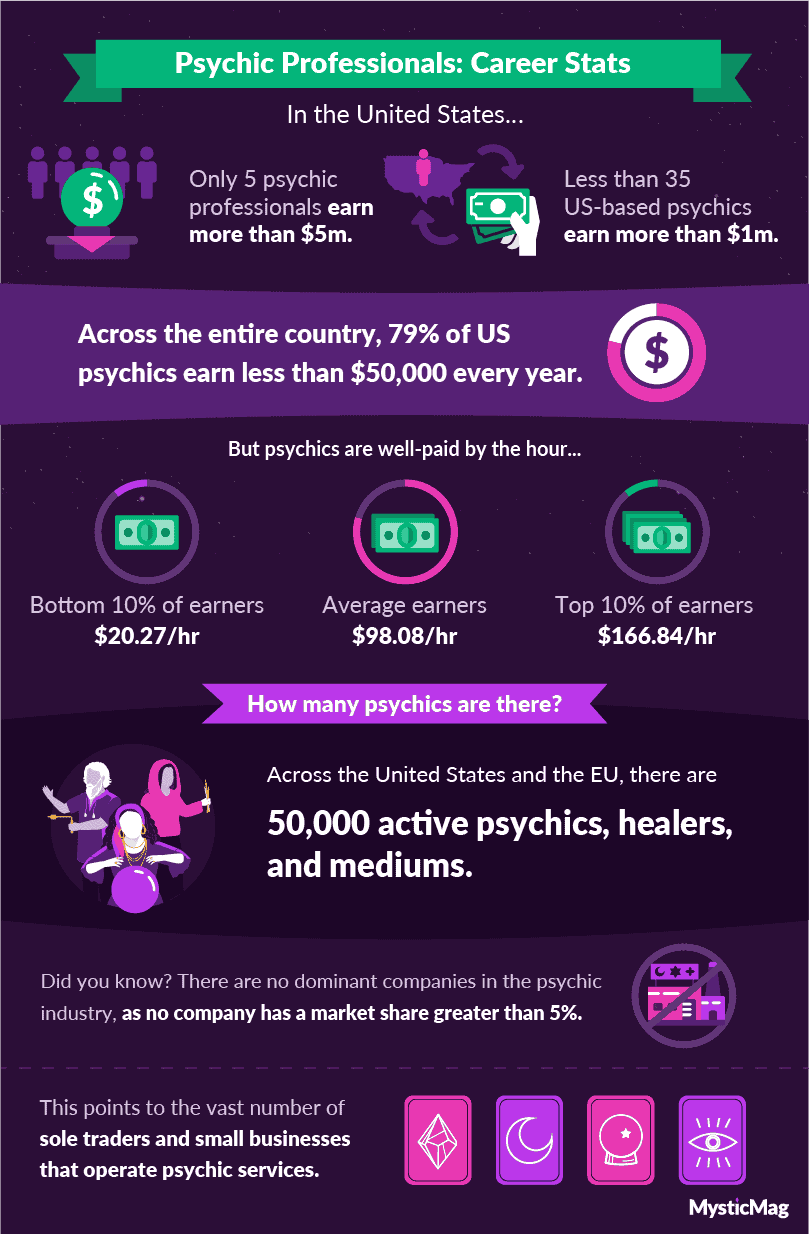
That no major players have a market share greater than 5% points to the fact that metaphysical services are largely uncharted territory in the corporate world, and so they should be.
Psychics are traditionally sole proprietors, acting upon their own expertise without much need for colleagues or employees. In the modern world, psychics are often registered as freelancers, sole traders, or small businesses.
Typically, psychics don’t earn substantial yearly salaries unless they achieve celebrity status like John Edward or Colin Fry on TV. However, it’s worth noting that psychics often command high fees for their services. The available data indicates that psychics tend to work fewer hours compared to the average working adult, given their higher hourly rates, resulting in an annual wage that is relatively average in comparison.
Market Share
Let’s take a look at the market share in the psychic industry. Which type of psychic service is most popular, and generates the most amount of revenue? If you plan on getting into the psychic industry, this could be valuable information.
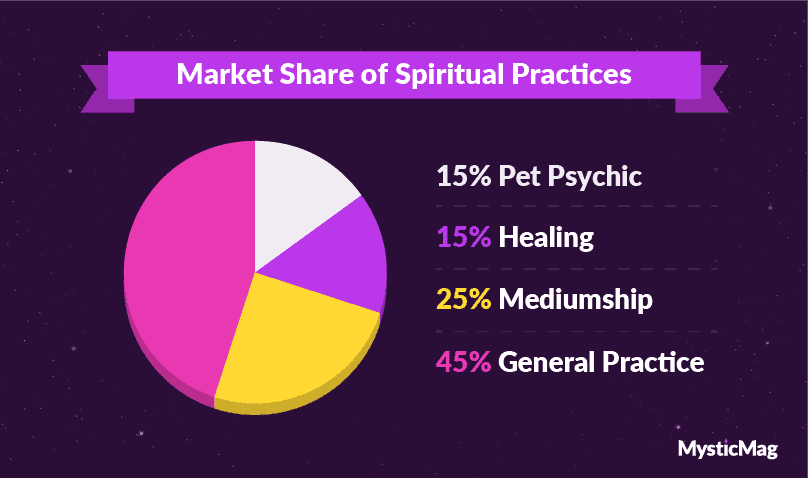
General practice is the broadest and most popular subsector of the psychic services industry, with a market share of 45%.
This category includes standard psychic reading and consultation based on romantic, personal, or business-related topics, such as employment and investment opportunities. Tarot readings, astrology, and other miscellaneous psychic services are also part of this category.
Those psychics who specialize in communications with spirits (mediums) are second on this list with a market share of 25%, which is slightly surprising given their mainstream popularity.
Two niche types of psychic practice, pet psychic and spiritual healers, finish 3rd and 4th on this list with 15% of the market share each.
Though these sub sectors command a smaller piece of the pie, that doesn’t mean talented healers or pet psychics can’t still generate good revenues when selling their services.
Industry Growth
The psychic industry is booming right now, with psychic services enjoying a 52% rise in the U.S. market size since 2005. The market is expected to expand another 2.6% to reach $2.2 billion in 2021 and will continue rising for the foreseeable future.
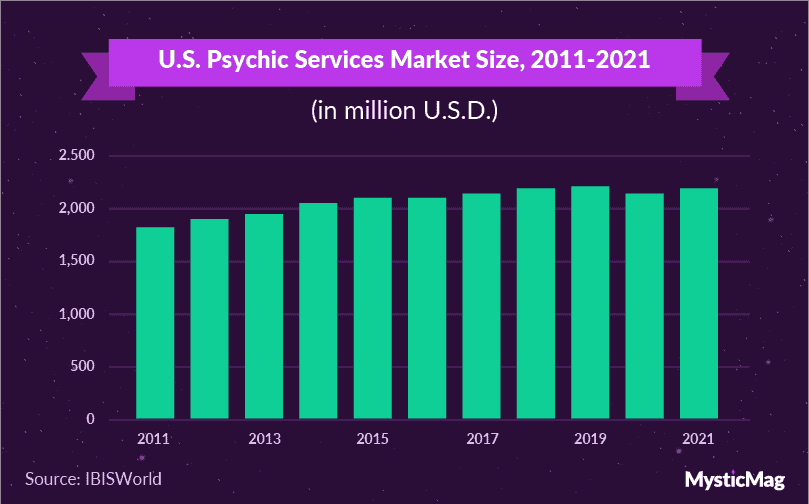
Psychic services are expected to reach between $2.3 billion to $2.4 billion by the end of 2024, owing to the continued resurgence that the industry is seeing over the last decade.
Over the past 5 years, the industry has enjoyed a year-on-year growth rate of 2%. The number of active psychic and tarot businesses has also risen throughout this period, up by 1.6%, while the number of employees has risen by 1.4%.
The current growth rate sits at 0.5% following the coronavirus pandemic, though this is expected to rise rapidly in the coming months.
Market Drivers
Despite so many other industries failing due to the economic impact of COVID-19, psychic services have coped very well. So, why is this the case?
Rising disposable income accounts for some portion of the sector’s expected growth over the next few years, but current performance owes to the nature of the work.
COVID-19 has been stressful for everyone, not least businesses that are trying to stay afloat or families that are mourning the loss of loved ones. People have needed more spiritual guidance than ever before within this context, which is why the industry is doing reasonably well.
Customers may be seeking spiritual advice about their next career move or business decision, they could be hoping to find out the fortunes of their business and family, or hoping to reconnect with those they have lost.
The industry has been able to transition online seamlessly, as social distancing rules forced the closure of many high street shops and establishments.
Psychics have used online marketplaces and over-the-phone services to maintain their business operations and limit the loss of revenue. Their use of social media, and electronic communications such as email newsletters, also marks the industry for growth in popularity amongst younger audiences.
In any case, the industry’s current accessibility, coupled with a general desire to use psychic services, means psychics around the world are enjoying their best period in years.
IBIS’ report mentions other factors that will play a factor in future growth, including general demand for entertainment from bars and nightclubs, as well as the current size of the industry’s primary demographic (20-60-year-olds). The increasing female participation in the industry will also contribute to its growth.
According to IBIS, there will be 4 key buying sectors and 4 key selling sectors behind growth in U.S. psychic services and products.
Key buying industries:
- Magazine & Periodical Publishing Companies
- Amusement Parks
- Bars & Nightclubs
- General Consumers
Key selling industries:
- Consumer Electronics Stores
- Small Specialty Retail Stores
- Commercial Leasing
- E-Commerce & Online Auctions
The key takeaways here are that the entertainment industry will continue to invest in psychics following the COVID-19 pandemic, while e-commerce’s appearance on the “sellers” list marks an expectation that many psychics will continue to sell their services online.
PRS is a Big Revenue Source
As has been mentioned briefly, many psychics charge customers via premium rate services.
Essentially, these are psychic services that are charged to your phone bill. More often than not, premium rate services come in the form of a pay-per-minute phone-in service, such as a fortune-telling phone service.
Psychic services are one of the most popular types of premium rate service available to consumers.
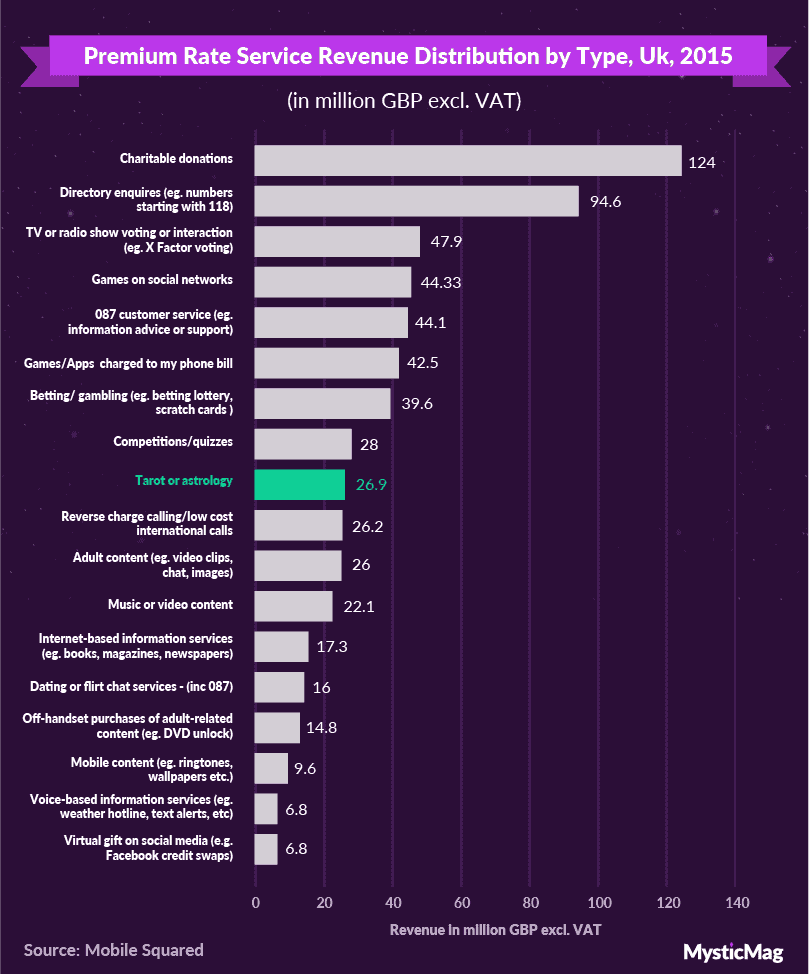
“Tarot or astrology” services rank as one of the highest-grossing premium rate services in the United Kingdom. These services generate around £27 million of revenue a year and rank as the 9th highest-grossing premium rate service in the UK in 2015.
In other words, becoming an over-the-phone psychic could be a profitable place to sell your services as a psychic professional, although no platform is expected to see the same rise as the internet.
Online Growth
Throughout the last few years, the online world has opened up a host of business opportunities. Industries are moving online at a rapid pace following the COVID-19 pandemic, which has only served to accelerate this trend.
This is no different for psychics, so here are some statistics about psychic services online.
Psychic Apps Are Popular
Airnow has done a ton of research on the most popular lifestyle apps in Nordic countries.
However off-topic it may sound (stay with me here), Airnow’s insights could give us an idea of the popularity of online psychic apps.
Across Norway, Finland, and Denmark, the results of the study are pretty similar. Let’s take a look at lifestyle apps in Denmark first.
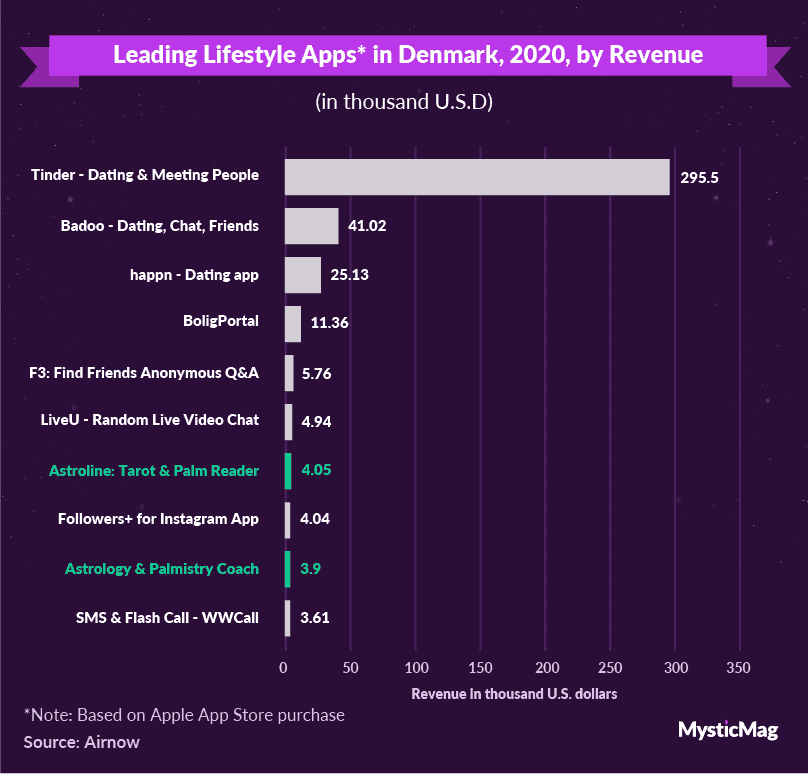
The “Astrology & Palmistry Coach” and “Astroline” are both featured among the top 10 grossing apps in Denmark. In 2020, Astroline has generated $4,500 of revenue in Denmark, while the Astrology & Palmistry Coach isn’t far behind, with a revenue of $3,900.
That was enough to rank these psychic apps as the 7th and 9th biggest lifestyle apps in the country.
Similar results could be found in Norway, where Astroline generated $4,620 revenue and the Astrology & Palmistry coach app generated slightly less, at $2,830. This was enough to rank them 7th and 10th among all lifestyle apps.
In Finland, although profits were lower due to the relatively small population, the Astrology & Palmistry app still managed to rank as the 10th leading lifestyle app in the country.
So, what do these results tell us?
Airnow’s study demonstrates the growing mainstream popularity of fortune-telling apps, and the fact two of them were able to generate a large following is a sign of continued success.
Astrology and palm reading apps seem to be the two most popular types of psychic application, and setting one up in Finland, Denmark, or Norway wouldn’t be a bad idea based on these results.
However, the most important thing we can say is that there is now a big market for psychic apps in general. If you are a professional psychic, you should think about piling your knowledge into an application.
As a spiritual person, the results also show that a lot of people love to use psychic services on an app. Maybe you could benefit from using psychic apps too!
Psychic Apps Revenue Growth
Sensor Tower’s study shows how online psychic services have increasingly generated profits over the past few years, specifically in terms of those using astrology applications.
The data shows that spending has increased rapidly between 2016 and 2019.
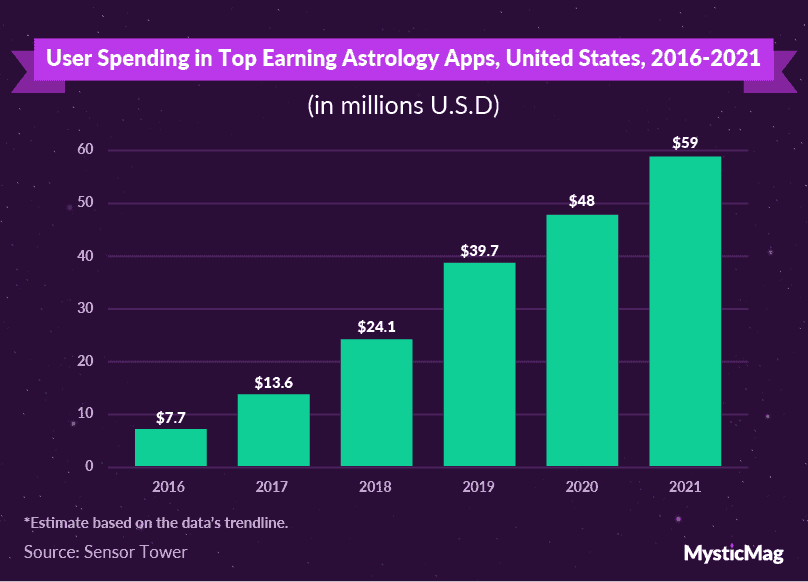
More people are using astrology apps nowadays, and more people are spending money on them as a result. This just goes to show that psychic services that are not face-to-face are becoming more popular, and can still generate massive profits.
Though we await fresh data on this particular topic, the growth seen from 2016 through 2019 would posit the current spend at around $59 million in 2021. This value is probably even greater in reality, given the growth many apps are now seeing following the COVID-19 pandemic.
People Spend on Psychic Services Online
Taking a look at Google AdWords offers another good indicator of what people are willing to spend on psychic services online.
The graph below charts the amount of money people spend, on average, after searching keywords on Google.
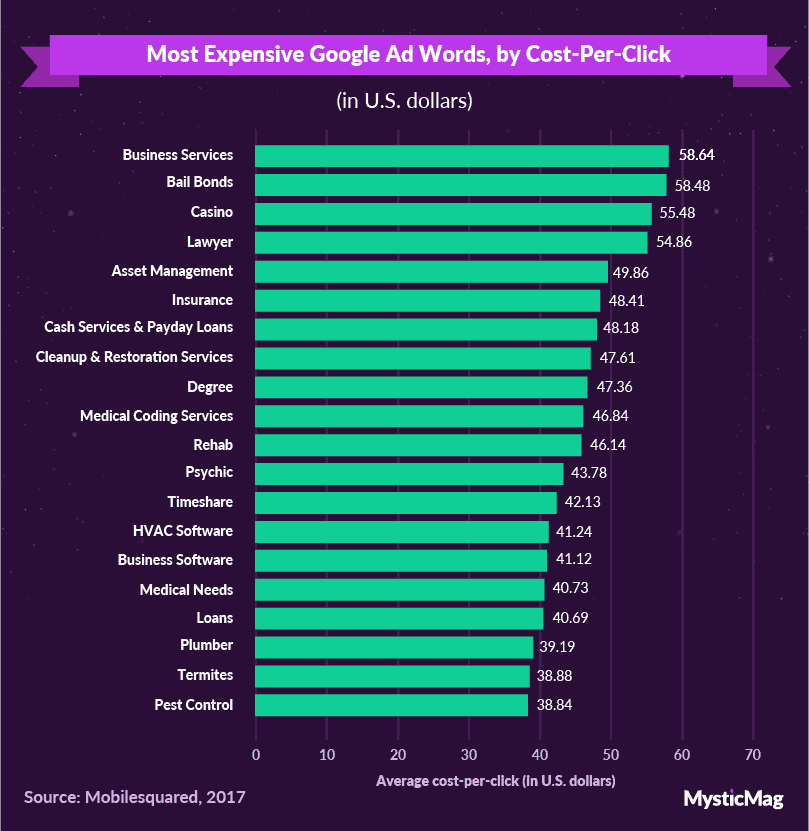
The term “psychic” does make it onto the list, featuring as the 12th most profitable keyword that people search for when using Google.
According to Mobilesquared, those who search “psychic” spend around $44 on products/services.
If you are a psychic looking for business opportunities, this should be music to your ears. People really are willing to pay for psychic services online, so launching your business on the internet could be a great idea.
You should plan to integrate areas of your business onto the internet if you’re already a psychic, too. Given the profitability of the term, having the best social media presence or website could be crucial for catching valuable customers.
Conclusion
We’ve covered everything from public opinions of psychic services and general psychic beliefs, to the psychic industry itself.
It’s an industry that is faring better than most at this moment in time. With that in mind, we can expect to see more mainstream psychic services popping up over the next few years.
Whether you’re a psychic professional or simply a lover of all things spiritual, hopefully the statistics in this article can help bring some value to your life, your spirituality, and your understanding of the psychic industry as a whole.
That’s all for psychic, mediumship, and tarot statistics in 2021. Have a wonderful day!



